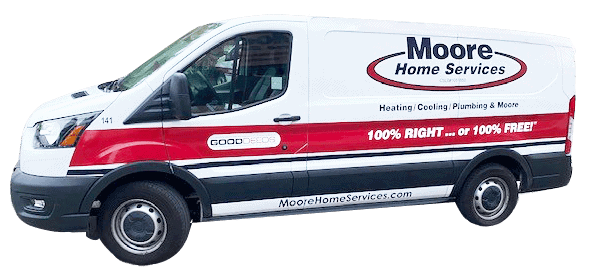What do We Check During a Furnace Tune-Up?
Posted by Moore Home Services
HVAC Basics
It’s true that the best thing you can do for your furnace is to schedule routine maintenance. But what do HVAC techs look at when they conduct an 18-point furnace tune-up? Today, we’re going into the nitty gritty details and taking you step by step through a routine tune-up.
During a furnace tune-up our techs break everything into 3 main parts: furnace inspection, cleaning the furnace, and tests and measurements. This allows our HVAC technicians to truly look at every part of your HVAC system to ensure safety and reliability. Below is a list of everything we inspect and why.
#1 Furnace Tune-Up Inspection
Heat Exchanger
A
heat exchanger allows the furnace to do its basic job: add warmth to ambient air. This device passes heat between two or more fluid gasses. This works because the heat exchanger has a hole at the bottom and a hole at the top. When burners turn on and generate combustion gas, they send that gas into the first hole.
As combustion gas is being generated, the system will pull outdoor air over the top of the heat exchanger. The gas inside the heat exchanger warms the outdoor air and sends that now hot air through your home.
The combustion gas, and any other harmful gasses, will then exit through the second hole in the heat exchanger. The gasses go into a flue where they are released outside of the home. This keeps any harmful gasses from entering in your home or HVAC system.
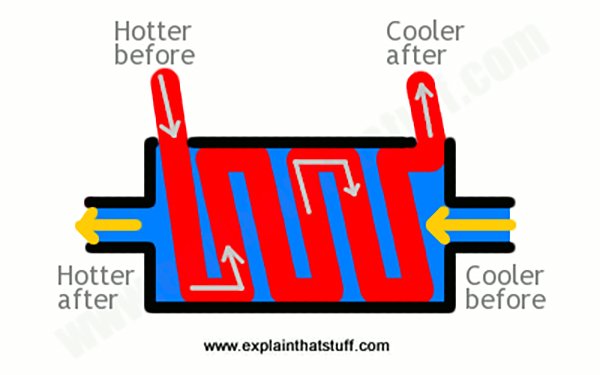
While conducting a furnace tune-up, a Moore technician will completely take apart the heat exchanger to make sure its safely transferring gasses. Over time and with use small cracks and fissures can appear in the heat exchanger. It’s a technician’s responsibility to let you know if the heat exchanger is still operating at a safe condition.
Duct Supply and Return
You know those vents on your floorboards or near your ceiling? They preform two very important jobs. Supply vents pull air from inside your home and return vents distribute treated air throughout the house.
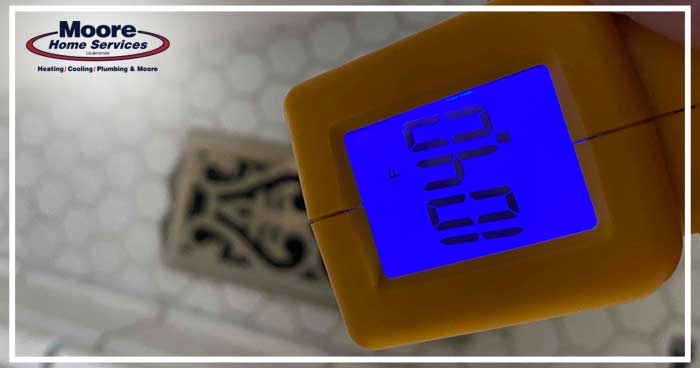
When our tech first enters your home, he or she will ask you to turn on the thermostat. They do this to take a temperature reading at every supply and return vent. This is because there is a temperature ratio that needs to be maintained between the supply and return.
Combustible Material Around the Furnace
Any functional furnace needs to have lots of oxygen. We understand that furnaces are often placed in attics and utility closets, which are great places for storage. However, it’s far too often we see homeowners cramming holiday decorations and other storage items too close to their furnace.
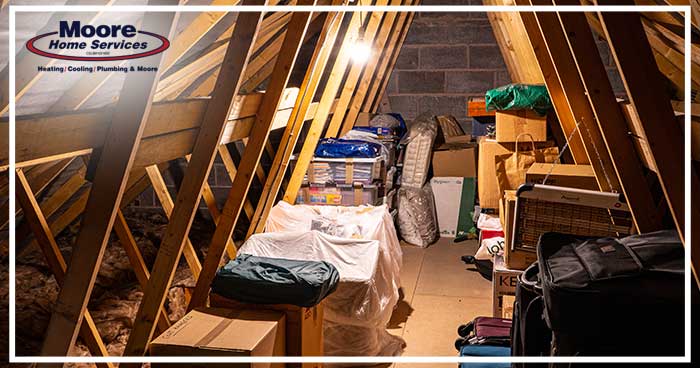
We advise leaving 3 ft. of space between your furnace and any storage items. With too many things in close proximity to your furnace, the system doesn’t have the crucial ventilation it needs. This could lead to excess strain on your system and even premature failure. When conducting your
furnace tune-up, a Moore Home Services technician will let you know if anything is too close to your furnace.
#2 Cleaning the Furnace.
Furnace Exterior
Because furnaces are often found in places that accumulate dust—i.e., your attic—they can develop a fine layer of grime. When we send our techs into the field, they are all equipped with a shop vac. They use this to clean your unit until it looks as good as new.
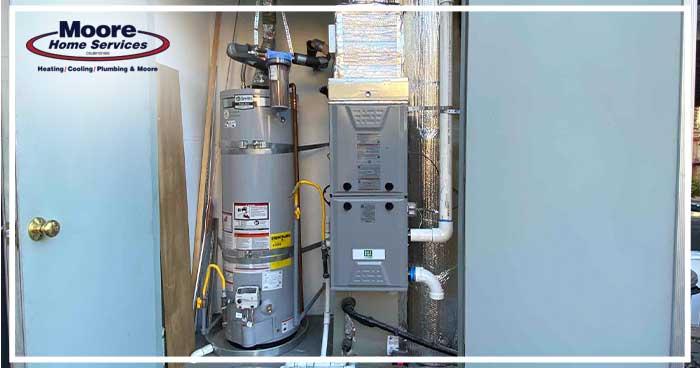
Burner Compartment
Without the burner compartment there would be no heat. Gas and air mix freely in this section, which in turn creates warm air. To check the burner compartment, we take out most of the components and thoroughly clean each one. This step is so important because modern burner compartments are packed with a ton of safety features.

If anything is obstructing a burner—even something as small as a spider web—that burner won’t turn on. Keeping it clean ensures the entire HVAC system is running at peak efficiency and at optimal safety levels. We don’t want anything, not even a spider web, to stand in the way of elevated home comfort.
Filter, Standard 1” (Wash or Replace)
Next to scheduling routine maintenance, the most important thing you can do for your furnace is to
regularly change the air filter. Our technicians are taught this on day one of their HVAC training.
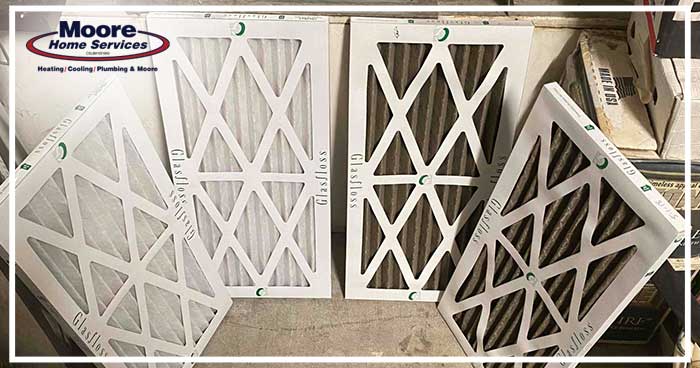
As part of a standard tune-up, a technician will be sure to
change out your air filter depending on what type you have. The techs keep a standard 1” washable air filter in their vans, but if you have something you prefer, we’re happy to change it for you. If you do have a washable filter already in place, our techs will take it out, clean it, wait for it to fully dry, then put it back for you.
Blower Assembly
The blower motor and the assembly it’s housed in are critical parts of your furnace. Without a blower motor, no warm air could circulate through your home. And without the blower assembly, the motor can’t properly function.
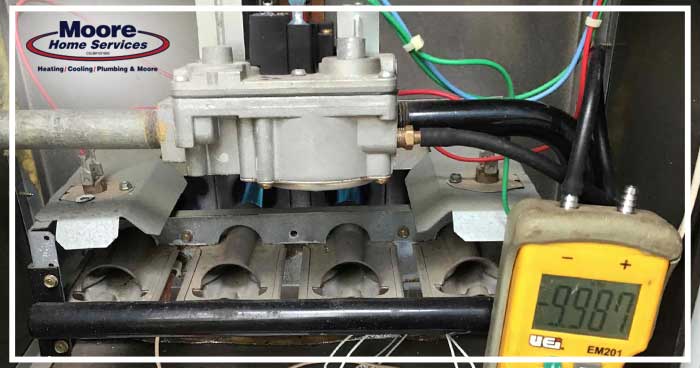
#3 Test and Measure
Electrical Wiring
Wiring can be tricky. It’s such an important part of any HVAC system, but can be knocked out of place by the routine vibrations that come along with heating and cooling cycles.
When our techs examine your system, they want to make sure all the electrical connections are strong and in working order. If they come across anything that needs to be fixed, they can do it on the spot, no need to call an electrician or outside contractor.

A loose connection that’s left for too long can generate a lot of resistance. That resistance leads to heat which can make for an unsafe operation. Our first order of business is to make sure everything is as safe as possible.
Thermostat Evaluation
Above, we mentioned that we ask homeowners to turn their thermostat when we start the tune-up. Though we do use this to check the supply and return temperatures, we also to this to conduct a full thermostat evaluation.

We do this so that we can take the vitals of your HVAC system. An issue we routinely run into is thermostat placement. Bad thermostat placement can lead to improper temperature readings which can throw off your entire HVAC operation.
Exhaust System Venting
Central heating systems all make and release exhaust. The important thing that some homeowners, and even contractors, forget is that the exhaust has to go somewhere. A point on our tune-up list is to ensure the
flue pipe is intact and correctly doing its job.
Unfortunately, there are a number of contractors and DIYers who don’t know how important this little pipe is. Because of this, the flue pipe can easily be disconnected, or even collapse during renovations.
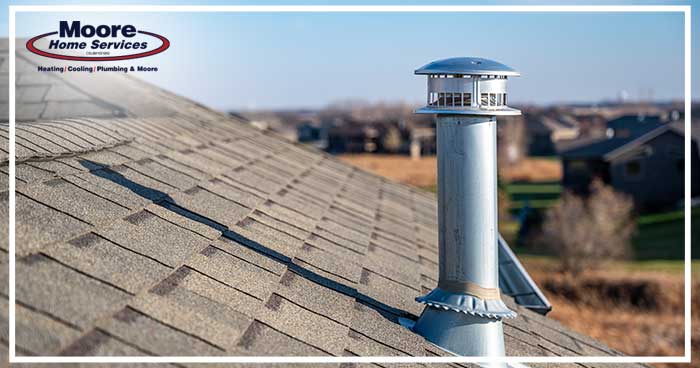
While a collapsed flue pipe isn’t always a problem, it becomes a problem when ductwork isn’t fully sealed. About 50-60% of ducting has very small leaks that has the potential to let poisonous gasses into a home.
Ignition System Operation
This point only applies to furnaces with a pilot light. Many modern systems have moved away from using pilot lights. However, with a season of use, pilot lights can get dirty and generate a lot of buildup.
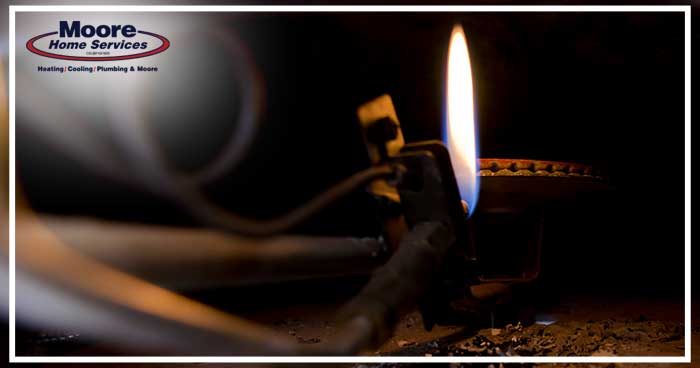
That buildup can grow so much that the pilot light has a problem igniting. Our technicians will clean the pilot light and area around it to make sure it’s safe and working reliably.
Combustion Gas Leakage
Even a small gas leak can be a gigantic issue. We’ve trained our technicians to examine every part of a gas line to ensure the safety of you and your family. They also check fittings on the furnace and water heater to make sure nothing is loose or damaged.
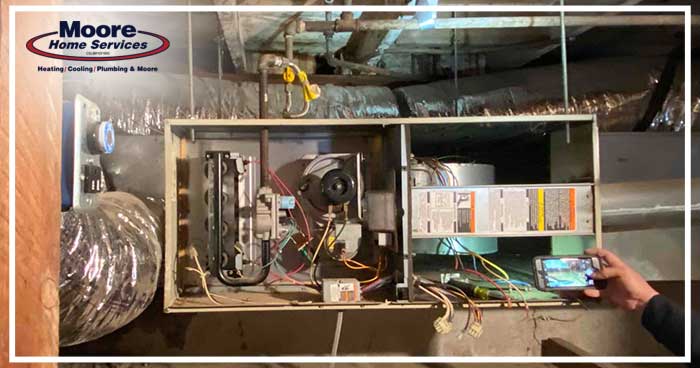
A safety issue with most HVAC systems is that they will never give any warning that a gas leak is present.
Measure and Adjust Gas Pressure
Gas leaks aren’t the only thing we check for. Your technician will also measure and, if needed, adjust your gas pressure during a furnace tune-up. We can measure gas pressure through a water column in your furnace.
Every heating unit is engineered with a specific gas pressure rating. Our techs will measure the pressure and if it falls above or below the specified rating, your HVAC tech will adjust everything until it’s in the correct place.
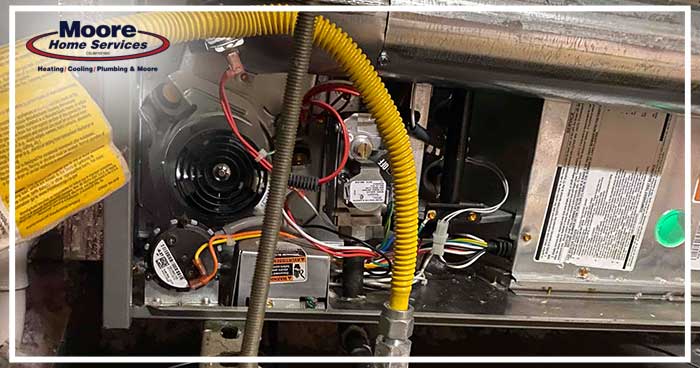
If you’re asking why gas pressure matters, it all boils down to temperature. Too much pressure mans your system can easily overheat, which will wear the system down before the end of its intended lifespan.
Secondary Motor Control Operation
Your furnace’s program is like a merry-go-round. It needs to be constantly circling at a controlled speed to properly distribute heat throughout your home. The heater motor can go faster than it should and the whole system could start to wear out if the secondary motor control is malfunctioning.
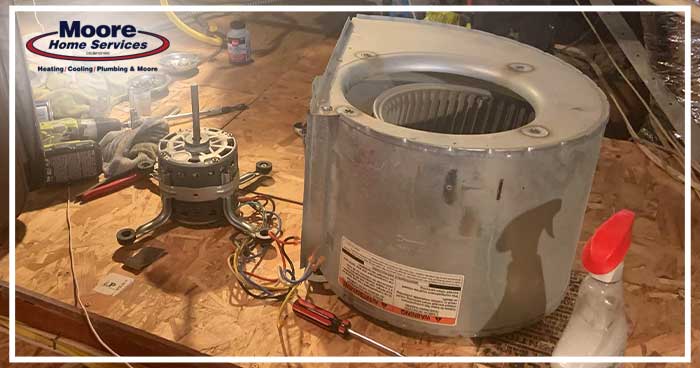
Safety and Control Circuits Operation
Today’s HVAC safety features are like nothing that came before. Older heating and cooling systems do not have the same safeguards in place, so we’re thankful for the all the innovations in the industry. Perhaps the thing we’re most grateful for is the sensor that hides in a furnace’s firebox.

If something ever gets sucked into the firebox, the coil gets dirty, or the furnace can’t properly ignite, a safety sensor will shut the whole system down. At Moore, we like to call this small sensor the “lifesaver” because it has literally saved lives.
Blower Motor Amperage and Voltage
Remember the blower assembly we talked about earlier? That assembly is home to the blower motor. Because this is a crucial part of any HVAC system, we like to take our time to make sure it’s working correctly.
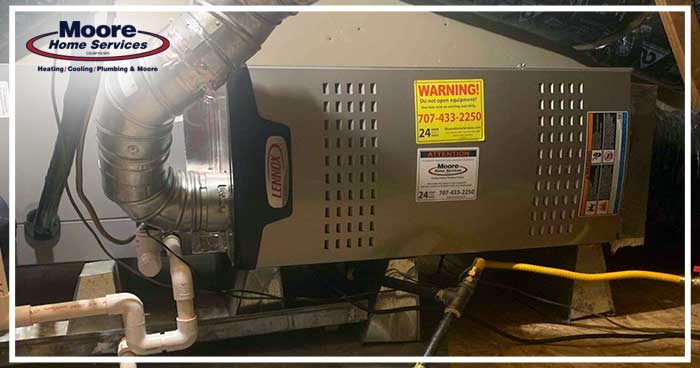
All blower motors have predesignated amperage and voltage levels. The motor itself would need to be replaced once it goes past the specific levels. If the motor is not working correctly, the system can create heat, but with a potentially unsafe operation. You do have the option to replace the blower motor, it’s one of the ways we stay ahead of needing to replace the entire system.
Temperature Difference at Supply and Return
This point may look familiar to you. That’s because it’s also in the inspection phase. During the testing and measuring phase, our techs will check the temperatures in the supplies and the returns. They do this because there needs to be an even ratio between the temperatures.
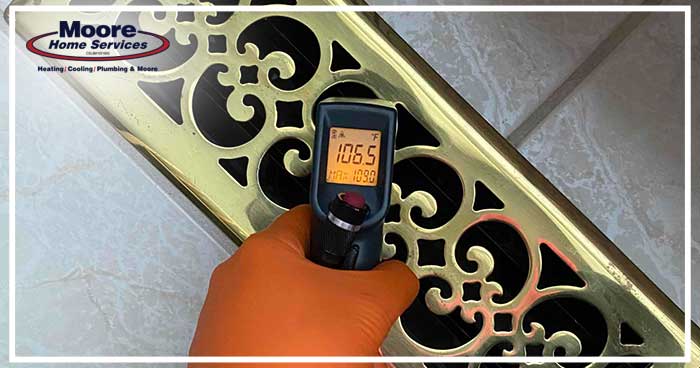
A large difference in temperature could indicate a problem with the gas pressure or fan speed. As we’ve mentioned before, too much overheating can cause premature system failure. The number one reason we preform tune-ups is to make sure you get the maximum usage out of your HVAC system.
It’s Never too Late for a Furnace Tune-Up, Schedule Yours Today
Do you still need to schedule a tune-up? Truth be told, it’s never too late in the season to have your HVAC system checked out. To meet your expert, simply call the number at the top of the screen or
click here to book an appointment online. Moore Home Services proudly serves our Sonoma, Santa Rosa, and North Bay communities. This is also a great opportunity to check out our Moore-Rewards program. Members receive automatic calls to schedule their tune-ups. Take something off your to-do list and put it on ours.
 While conducting a furnace tune-up, a Moore technician will completely take apart the heat exchanger to make sure its safely transferring gasses. Over time and with use small cracks and fissures can appear in the heat exchanger. It’s a technician’s responsibility to let you know if the heat exchanger is still operating at a safe condition.
While conducting a furnace tune-up, a Moore technician will completely take apart the heat exchanger to make sure its safely transferring gasses. Over time and with use small cracks and fissures can appear in the heat exchanger. It’s a technician’s responsibility to let you know if the heat exchanger is still operating at a safe condition.
 When our tech first enters your home, he or she will ask you to turn on the thermostat. They do this to take a temperature reading at every supply and return vent. This is because there is a temperature ratio that needs to be maintained between the supply and return.
When our tech first enters your home, he or she will ask you to turn on the thermostat. They do this to take a temperature reading at every supply and return vent. This is because there is a temperature ratio that needs to be maintained between the supply and return.
 We advise leaving 3 ft. of space between your furnace and any storage items. With too many things in close proximity to your furnace, the system doesn’t have the crucial ventilation it needs. This could lead to excess strain on your system and even premature failure. When conducting your furnace tune-up, a Moore Home Services technician will let you know if anything is too close to your furnace.
We advise leaving 3 ft. of space between your furnace and any storage items. With too many things in close proximity to your furnace, the system doesn’t have the crucial ventilation it needs. This could lead to excess strain on your system and even premature failure. When conducting your furnace tune-up, a Moore Home Services technician will let you know if anything is too close to your furnace.

 If anything is obstructing a burner—even something as small as a spider web—that burner won’t turn on. Keeping it clean ensures the entire HVAC system is running at peak efficiency and at optimal safety levels. We don’t want anything, not even a spider web, to stand in the way of elevated home comfort.
If anything is obstructing a burner—even something as small as a spider web—that burner won’t turn on. Keeping it clean ensures the entire HVAC system is running at peak efficiency and at optimal safety levels. We don’t want anything, not even a spider web, to stand in the way of elevated home comfort.
 As part of a standard tune-up, a technician will be sure to change out your air filter depending on what type you have. The techs keep a standard 1” washable air filter in their vans, but if you have something you prefer, we’re happy to change it for you. If you do have a washable filter already in place, our techs will take it out, clean it, wait for it to fully dry, then put it back for you.
As part of a standard tune-up, a technician will be sure to change out your air filter depending on what type you have. The techs keep a standard 1” washable air filter in their vans, but if you have something you prefer, we’re happy to change it for you. If you do have a washable filter already in place, our techs will take it out, clean it, wait for it to fully dry, then put it back for you.

 A loose connection that’s left for too long can generate a lot of resistance. That resistance leads to heat which can make for an unsafe operation. Our first order of business is to make sure everything is as safe as possible.
A loose connection that’s left for too long can generate a lot of resistance. That resistance leads to heat which can make for an unsafe operation. Our first order of business is to make sure everything is as safe as possible.
 We do this so that we can take the vitals of your HVAC system. An issue we routinely run into is thermostat placement. Bad thermostat placement can lead to improper temperature readings which can throw off your entire HVAC operation.
We do this so that we can take the vitals of your HVAC system. An issue we routinely run into is thermostat placement. Bad thermostat placement can lead to improper temperature readings which can throw off your entire HVAC operation.
 While a collapsed flue pipe isn’t always a problem, it becomes a problem when ductwork isn’t fully sealed. About 50-60% of ducting has very small leaks that has the potential to let poisonous gasses into a home.
While a collapsed flue pipe isn’t always a problem, it becomes a problem when ductwork isn’t fully sealed. About 50-60% of ducting has very small leaks that has the potential to let poisonous gasses into a home.
 That buildup can grow so much that the pilot light has a problem igniting. Our technicians will clean the pilot light and area around it to make sure it’s safe and working reliably.
That buildup can grow so much that the pilot light has a problem igniting. Our technicians will clean the pilot light and area around it to make sure it’s safe and working reliably.
 A safety issue with most HVAC systems is that they will never give any warning that a gas leak is present.
A safety issue with most HVAC systems is that they will never give any warning that a gas leak is present.
 If you’re asking why gas pressure matters, it all boils down to temperature. Too much pressure mans your system can easily overheat, which will wear the system down before the end of its intended lifespan.
If you’re asking why gas pressure matters, it all boils down to temperature. Too much pressure mans your system can easily overheat, which will wear the system down before the end of its intended lifespan.

 If something ever gets sucked into the firebox, the coil gets dirty, or the furnace can’t properly ignite, a safety sensor will shut the whole system down. At Moore, we like to call this small sensor the “lifesaver” because it has literally saved lives.
If something ever gets sucked into the firebox, the coil gets dirty, or the furnace can’t properly ignite, a safety sensor will shut the whole system down. At Moore, we like to call this small sensor the “lifesaver” because it has literally saved lives.
 All blower motors have predesignated amperage and voltage levels. The motor itself would need to be replaced once it goes past the specific levels. If the motor is not working correctly, the system can create heat, but with a potentially unsafe operation. You do have the option to replace the blower motor, it’s one of the ways we stay ahead of needing to replace the entire system.
All blower motors have predesignated amperage and voltage levels. The motor itself would need to be replaced once it goes past the specific levels. If the motor is not working correctly, the system can create heat, but with a potentially unsafe operation. You do have the option to replace the blower motor, it’s one of the ways we stay ahead of needing to replace the entire system.
 A large difference in temperature could indicate a problem with the gas pressure or fan speed. As we’ve mentioned before, too much overheating can cause premature system failure. The number one reason we preform tune-ups is to make sure you get the maximum usage out of your HVAC system.
A large difference in temperature could indicate a problem with the gas pressure or fan speed. As we’ve mentioned before, too much overheating can cause premature system failure. The number one reason we preform tune-ups is to make sure you get the maximum usage out of your HVAC system.

